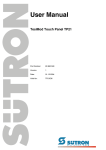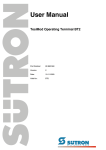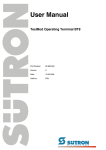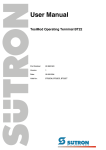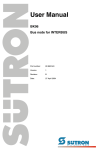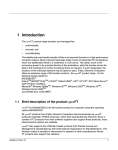Download User Manual - Sütron electronic GmbH
Transcript
User Manual Connection to DeviceNet Part Number: 80 860.642 Version: 1 Date: 12.07.2005 Valid for: TSwin .net 4.0x Version 1 Date 12.07.2005 Modifications First edition This manual, including all illustrations contained herein, is copyright protected. Use of this manual by any third party in departure from the copyright provision is forbidden. No part of this manual may be reproduced, translated or electronically or photographically archived or altered without the express written consent from Sütron electronic GmbH. Violations shall be cause for damage liability. Sütron electronic reserves the right to make any changes that contribute to technical improvement. Overall Table of Contents Overall Table of Contents 1 DeviceNet ................................................................................................................ 1-1 1.1 Explicit Message ....................................................................................... 1-1 1.1.1 Storing Data ......................................................................................... 1-1 1.1.2 Exchanging Data ................................................................................. 1-1 1.1.3 Data Memory ....................................................................................... 1-2 1.1.4 Read Service ....................................................................................... 1-2 1.1.5 Write Service ....................................................................................... 1-3 1.1.6 Fragmentation...................................................................................... 1-4 1.2 Poll I/O Connection ................................................................................... 1-4 1.2.1 Receive Data of the Operating Device (Consumed Data) ................... 1-4 1.2.2 Transmit Data of the Operating Device (Produced Data) .................... 1-4 1.2.2.1 Byte 1 - Initialization....................................................................................................1-5 1.2.2.2 Byte 2 - Control Byte...................................................................................................1-5 1.2.2.3 Byte 3 and Byte 4 - Word Address .............................................................................1-5 1.2.2.4 Byte 5 - Number of Bytes............................................................................................1-6 1.2.3 Module/Network Status........................................................................ 1-6 1.3 Programming ............................................................................................ 1-6 1.3.1 Protocol Parameters ............................................................................ 1-6 1.3.1.1 Baud Rate...................................................................................................................1-6 1.3.1.2 Node Number .............................................................................................................1-6 1.3.1.3 Delay until Connection Set-Up....................................................................................1-7 1.3.1.4 Waiting Time for Response ........................................................................................1-7 1.3.1.5 Attribute ......................................................................................................................1-7 1.3.1.6 Byte Order ..................................................................................................................1-7 1.3.2 Input Syntax ......................................................................................... 1-9 1.3.3 Variables .............................................................................................. 1-9 1.3.4 System Variables ................................................................................. 1-9 1.3.4.1 ComBaudrateA ...........................................................................................................1-9 1.3.4.2 ComHandshakeA......................................................................................................1-10 1.4 Object Definitions.................................................................................... 1-10 1.4.1 Identity Object .................................................................................... 1-10 1.4.1.1 Class Attribute of Identity Object ..............................................................................1-10 1.4.1.2 Instance Attribute of the Identity Object....................................................................1-10 1.4.1.3 Instance Service of the Identity Object .....................................................................1-11 1.4.1.4 Message Router Object ............................................................................................1-11 1.4.2 DeviceNet Object ............................................................................... 1-11 1.4.2.1 Class Attribute of the DeviceNet Object ...................................................................1-11 1.4.2.2 Instance Attribute of the DeviceNet Object...............................................................1-11 1.4.2.3 Instance Service of the DeviceNet Object ................................................................1-11 1.4.3 Assembly Object ................................................................................ 1-12 1.4.3.1 Class Attribute of the Assembly Object ....................................................................1-12 1.4.3.2 Instance 1 Attribute - Static Input - of the Assembly Object .....................................1-12 1.4.3.3 Instance 2 Attribute - Static Output - of the Assembly Object...................................1-12 1.4.4 Connection Object ............................................................................. 1-12 1.4.4.1 Class Attribute of the Connection Object..................................................................1-12 1.4.4.2 Instance Attribute of the Connection Object .............................................................1-12 i Overall Table of Contents 1.4.4.3 Instance Service of the Connection Object .............................................................. 1-13 1.4.5 BT Object ........................................................................................... 1-13 1.4.5.1 Instance Service of the BT Object ............................................................................ 1-13 1.5 Format of the Explicit Message............................................................... 1-16 1.6 EDS File .................................................................................................. 1-18 1.7 Physical Interfacing ................................................................................. 1-18 1.7.1 A ii DeviceNet, 9 Pin D-SUB .................................................................... 1-18 1.7.1.1 Pin Assignment......................................................................................................... 1-19 1.7.2 DeviceNet, 5 Pin Male Connector Strip ............................................. 1-19 1.7.2.1 Pin Assignment......................................................................................................... 1-20 1.7.3 Cable DeviceNet, 9 Pin D-SUB.......................................................... 1-22 1.7.4 Cable DeviceNet, 5 Pin Male Connector Strip ................................... 1-22 1.8 Error Messages....................................................................................... 1-23 1.9 Applications............................................................................................. 1-24 1.9.1 OMRON DRM 21-V1 ......................................................................... 1-24 1.9.2 Rexroth PPC ...................................................................................... 1-24 1.9.3 Rockwell RS Logix 5555 - 1756 DNB ................................................ 1-25 1.9.4 Rockwell SLC 505 - 1747 SDN/B ...................................................... 1-25 Index ....................................................................................................................... A-1 DeviceNet 1 DeviceNet The operating device is incorporated into the DeviceNet network as a DeviceNet slave. The communication between a controller (master or scanner) and the operating device (slave) is based on the Predefined Master/Slave Connection Set. Explicit Message Connections and Poll I/O Connections are used as Connection Instances. 1.1 Explicit Message Explicit Messages are used to exchange data between the operating device and the controller. This requires you to create a function block in the controller which assembles the payload into Explicit Messages. 1.1.1 Storing Data All data displayed by the operating device are stored in the operating device’s data memory. The size of the data memory is 2500 words. The data memory is word-oriented. The addresses are always word addresses, both from the operating device's and the controller's perspective. 1.1.2 Exchanging Data You need to create a program (function block) in the controller which is used to establish a data exchange between the operating device and the controller by means of Explicit Messages. For this, make sure that the data on both devices are consistent. New data in the controller has to be transferred to the operating device by Explicit Messages. The controller is informed about new data in the operating device by I/O Poll Telegram. The controller has to read the data from the operating device by Explicit Message. Operating Unit (DeviceNet Slave) read Display and Operating Unit write Figure 1-1 Explicit Message read write Data Memory Controller / PLC DeviceNet Slave read write DeviceNet Master Explicit Message write Controller Unit read Data exchange, DeviceNet 1-1 DeviceNet 1.1.3 Data Memory The data memory in the operating device is referred to as the Memory Object. The Memory Object Address has the following values. Table 1-1 Memory object addresses Address Name 0x8A Class ID 0x01 Instance ID 0x01 Attribute Comment Not Required The service – for a read access is 0x33 and – for a write access is 0x35. 1.1.4 Read Service The following table illustrates the structure of the Explicit Message for the Read service. Each field of the telegram is one byte long. Table 1-2 Structure of the Explicit Message for the Read service Byte Request Telegram Response Telegram 1 MAC ID MAC ID 2 Service ID 0x33 Service ID 0xB3 3 Class ID 0x8A 1st Data Word Low Byte 4 Instance ID 0x01 1st Data Word High Byte 5 Word Address Low Byte 2nd Data Word Low Byte 6 Word Address High Byte 2nd Data Word High Byte 7 Number of Bytes Low Byte 8 Number of Bytes High Byte The word address corresponds to the offset within the data memory in the operating device. 1-2 DeviceNet The byte order for the – word address, – number of bytes and – data word can be specified in the communication parameters. See chapter “Byte Order“ on page 1-7. 1.1.5 Write Service The following table illustrates the structure of the Explicit Message for the Write service. Each field of the telegram is one byte long. Table 1-3 Structure of the Explicit Message for the Write service Byte Request Telegram Response Telegram 1 MAC ID MAC ID 2 Service ID 0x35 Service ID 0xB5 3 Class ID 0x8A 4 Instance ID 0x01 5 Word Address Low Byte 6 Word Address High Byte 7 1st Data Word Low Byte 8 1st Data Word High Byte 9 2nd Data Word Low Byte 10 2nd Data Word High Byte The word address corresponds to the offset within the data memory in the operating device. 1-3 DeviceNet The byte order for the – word address, – number of bytes and – data word can be specified in the communication parameters. See chapter “Byte Order“ on page 1-7. 1.1.6 Fragmentation By means of fragmentation, up to 384 bytes can be transferred in one explicit message. 1.2 Poll I/O Connection On account of the EDS data, the Poll I/O Connection is installed automatically between the DeviceNet master and the operating device. With this connection, 2 bytes are transferred cyclically from the controller’s OUT area to the operating device and 5 bytes are transferred from the operating device to the IN area of the controller. 1.2.1 Receive Data of the Operating Device (Consumed Data) The Consumed Connection Size is 2 bytes. Table 1-4 Structure of the Consumed Data Byte Designation 1 Initialization 2 Control Byte 1.2.2 Transmit Data of the Operating Device (Produced Data) The Produced Connection size is 5 bytes. Table 1-5 1-4 Structure of the Produced Data Byte Designation 1 Initialization 2 Control Byte 3 Word Address - Low Byte 4 Word Address - High Byte 5 Number of Altered Bytes DeviceNet 1.2.2.1 Byte 1 - Initialization During the boot process, the operating device writes the value 0x00 into its Produced Data. Thus, the controller needs to initialize the entire data memory in the operating device once. Initialization means that all variable values in the data memory of the operating device are set the same as in the controller. When this process is completed, the controller writes the value 0xC3 into the Consumed Data. The operating device acknowledges by writing the value 0xC3 into the Produced Data. After the boot process, the operating device waits for the initialization to complete, before it accesses the data memory. If the initialization is not performed within the time period set for the Delay until Connection Setup, the following message appears. Figure 1-2 Message NO INITIALIZATION BY PLC To remove the message, press OK, the Help key or a key that calls up another screen. 1.2.2.2 Byte 2 - Control Byte During initialization, the control byte is set to the value 0x00. Bit 0: Bit 0 is the toggle bit. After you change a variable on the operating device, bit 0 in the Produced Data toggles. If the controller detects that bit 0 in the Produced Data and bit 0 in the Consumed Data do not match, the conroller has to read the changed data of the variable by „Explicit Message“. Once the read operation is complete, the controller sets the value of bit 0 in the Consumed Data to the same value as that of bit 0 in the Produced Data. If the controller detects that bit 0 in the Produced Data and bit 0 in the Consumed Data differ, bit 0 in the Consumed Data must be set to the same value as that of bit 0 in the Produced Data! If no bit synchronization takes place, the operating device displays the error message Timeout Error: Code 60, Subcode1“. Bit 1 to bit 7 Bits 1 to 7 are reserved. 1.2.2.3 Byte 3 and Byte 4 - Word Address Bytes 3 and 4 in the Produced Data contain the word address starting from which a variable has changed. The variable can be several bytes long. The controller uses this word address to selectively read the changed variable from the data memory of the operating device. 1-5 DeviceNet 1.2.2.4 Byte 5 - Number of Bytes Byte 5 in the Produced Data contains the number of bytes as the size information for the changed variable. 1.2.3 Module/Network Status The operating devices are not equipped with diagnostic LEDs for DeviceNet status indication. To indicate the module/network status, use the system variable ComBaudrateA instead. See chapter “ComBaudrateA“ on page 1-9. 1.3 Programming 1.3.1 Protocol Parameters With the protocol parameters, you can adapt the communication of the controller used. 1.3.1.1 Baud Rate This parameter specifies the communication rate. Table 1-6 Baud rate Configurable Values (kBaud) Default Value 125 X 250 500 1.3.1.2 Node Number Use the node number to set the MAC ID for the operating device. Table 1-7 1-6 Node number Configurable Values Default Value 0 to 63 0 DeviceNet 1.3.1.3 Delay until Connection Set-Up Specify this value to set the period of time the operating device waits before it sends the first Duplicate MAC ID Check Request Message. Messages arriving before this time has elapsed are not evaluated. Table 1-8 Delay until connection set-up Configurable Values Default Value 5 s to 255 s 5s 1.3.1.4 Waiting Time for Response Specify a waiting time for the Produced Data toggle bit monitoring. Table 1-9 Waiting time for response Configurable Values Default Value 0 ms, 50 ms to 65000 ms 500 ms See chapter “Byte 2 - Control Byte“ on page 1-5. 1.3.1.5 Attribute The Attribute parameter is not required in the Explicit Message to access the Memory Object. Some controllers do, however, force and transfer the Attribute parameter to generate an Explicit Message. In this case, select the check box: Explicit Message Contains the Parameter 'Attribute'. Table 1-10 Explicit Message contains the Attribute parameter Configurable Values Default Value OFF ON 1.3.1.6 X Byte Order The byte order for the DeviceNet protocol is Low-High. See Appendix J in Volume 1 of the DeviceNet Specification. The experience of some users has shown that some controllers do not use this byte order. In these cases, a byte-swap must be performed in the controller. For ease of programming, the user also has the option of swapping the byte order in the operating device. 1-7 DeviceNet Select two selection fields depending on the actual byte order: Table 1-11 Byte order Configurable Values Default Value Address/Length LowHigh X Data Low-High X Address/Length HighLow Data High-Low 1-8 DeviceNet 1.3.2 Input Syntax The following image illustrates the structure of the input syntax for variables in the programming software. W Number DW Figure 1-3 Syntax diagram 1.3.3 Variables h Number The variable addresses specify an offset in the data memory of the operating device. Table 1-12 Addresses in the data memory of the operating device Variable Name Address Word Access to Address 127 W 127 Word Access to the Highest Address W 2500 Double-Word Access to Address 371 DW 371 Double-Word Access to the Highest Address DW 2499 Bit Access to Bit 5 in Address 500 Bit Field Access to Bit 3 - Bit 12 in Address 1500 1.3.4 Low Byte High Byte W 500 5 5 W 1500 3 12 System Variables Since the operating devices do not have diagnostic LEDs, you need to use system variables to indicate specific DeviceNet statuses. You can create these system variables within any screen as output variables. To do so, select the representation type Selection Text and link the variable with a text list containing a text string for each status. 1.3.4.1 ComBaudrateA This system variable can be used to indicate the statuses of the module/network LED. Table 1-13 Statuses of the module/network LED Value Text Meaning 0 LED Off 1 LED Green Device is Assigned 2 LED Flashes Green DUP_MAC_ID Test is Okay But a Connection is Not Established 3 LED Flashes Red Connection Terminated After a Time Delay 4 LED Red BUS-OFF Status 5 LED Flashes Red And Green DUP_MAC_ID Error 1-9 DeviceNet 1.3.4.2 ComHandshakeA This system variable allows you to indicate whether the data memory has been initialized by the master. See chapter “Byte 1 - Initialization“ on page 1-5. Table 1-14 Table 1-16 Initialization states of the data memory Value Status 0 Not initialized 1 Initialized 1.4 Object Definitions Table 1-15 Object definitions Class ID Object Name 0x01 Identity Object 0x02 Message Router (Not Supported) 0x03 DeviceNet Object 0x04 Assembly Object (Not Supported) 0x05 Connection Object 0x8A BT Object 1.4.1 Identity Object 1.4.1.1 Class Attribute of Identity Object Class Attribute of Identity Object Attribute ID Attribute Name Access Rule Data Size (Byte) Attribute Value 0x01 Revision Get 2 (6-2.2) 0x01 1.4.1.2 Table 1-17 Instance Attribute of the Identity Object Instance Attribute of the Identity Object Attribute ID Attribute Name Access Rule Data Size (Byte) Attribute Value 0x01 Vendor ID Get 2 (6-2.2) 0x238 0x02 Device Type Get 2 0x00 0x03 Product Code Get 2 0x01 0x04 Revision Get 2 0x0101 (1.001) 1-10 DeviceNet Table 1-17 Instance Attribute of the Identity Object Attribute ID Attribute Name Access Rule Data Size (Byte) 0x05 Status Get 2 0x06 Serial Number Get 4 0x01 0x07 Product Name Get 32 DeviceNet For BT Series 1.4.1.3 Table 1-18 Attribute Value Instance Service of the Identity Object Instance Service of the Identity Object Service ID Service Name Description 0x0E Get_Attribute_Single Returns the Contents of the Specific Attribute 0x05 Reset Invoke the Reset Service in the BT 1.4.1.4 Message Router Object This object is not supported. Table 1-19 1.4.2 DeviceNet Object 1.4.2.1 Class Attribute of the DeviceNet Object Class Attribute of the DeviceNet Object Attribute ID Attribute Name Access Rule Data Size (Byte) Attribute Value 0x01 Revision ID Get 1 (5-5.3) 0x02 1.4.2.2 Table 1-20 Instance Attribute of the DeviceNet Object Instance Attribute of the DeviceNet Object Attribute ID Attribute Name Access Rule Data Size (Byte) 0x01 MAC ID Get 1 (5-5.3) 0x02 BaudRate Get 1 (5-5.3) 0x05 Allocation Information Get 1 (5-5.3) 1.4.2.3 Table 1-21 Attribute Value Instance Service of the DeviceNet Object Instance Service of the DeviceNet Object Service ID Service Name Description 0x0E Get_Attribute_Single Read attribute 0x4B Allocation Master/Slave Connection Set Request to use predefined master/slave connection set 0x4C Release Group 2 Identifier Set Release desired connection 1-11 DeviceNet Table 1-22 1.4.3 Assembly Object 1.4.3.1 Class Attribute of the Assembly Object Class Attribute of the Assembly Object Attribute ID Attribute Name Access Rule Data Size (Byte) Attribute Value 0x01 Revision Get 1 0x02 1.4.3.2 Table 1-23 Instance 1 Attribute - Static Input - of the Assembly Object Instance 1 Attribute - Static Input - of the Assembly Object Attribute ID Attribute Name Access Rule Data Size (Byte) 0x03 Set Data Get 5 1.4.3.3 Table 1-24 Instance 2 Attribute - Static Output - of the Assembly Object Instance 2 Attribute - Static Output - of the Assembly Object Attribute ID Attribute Name Access Rule Data Size (Byte) 0x03 Set Data Get 2 Table 1-25 Attribute Value Attribute Value 1.4.4 Connection Object 1.4.4.1 Class Attribute of the Connection Object Class Attribute of the Connection Object Attribute ID Attribute Name Access Rule Data Size (Byte) Attribute Value 0x01 Revision Get 1 0x01 1.4.4.2 Table 1-26 Instance Attribute of the Connection Object Instance Attribute of the Connection Object Attribute ID Attribute Name Access Rule Data Size (Byte) Value Expl. Value IO-Poll 0x01 State Get 1 0x02 Instance Type Get 1 0 1 0x03 TransportClass_Trigger Get 1 0x38 0x82 0x04 Produced Connection ID Get 2 0x05 Consumer Connection ID Get 2 0x06 Initial Comm Characteristics Get 1 0x21 0x01 0x07 Produced Connection Size Get 2 0xFFFF 5 0x08 Consumed Connection Size Get 2 0xFFFF 2 0x09 Expected Packed Rate Get/Set 2 Default Default 0x0C Watchdog Timeout Action Get/Set 1 Default Default 0x0D Produced Connection Path Length Get 2 0 6 1-12 DeviceNet Table 1-26 Instance Attribute of the Connection Object Attribute ID Attribute Name Access Rule Data Size (Byte) Value Expl. Value IO-Poll 0x0E Produced Connection Length Get 6 0 20 04 24 01 30 03 0x0F Consumed Connection Path Length Get 2 0 6 0x10 Consumed Connection Path Get 6 0 20 04 24 02 30 03 1.4.4.3 Table 1-27 Instance Service of the Connection Object Instance Service of the Connection Object Service ID Service Name Description 0x0E Get_Attribute_Single Read Attribute 0x10 Set_Attribute_Single Write Attribute Table 1-28 1.4.5 BT Object 1.4.5.1 Instance Service of the BT Object Instance Service of the BT Object Service ID Service Name Description 0x33 Block StringN Read Read Data by Each Data Unit 0x35 Block StringN Write Write Data by Each Data Unit Service ID = 0x33 (Block StringN Read) Table 1-29 Request without Attribute parameter Byte Designation 1 MAC ID 2 Service ID (0x33) 3 Class ID (0x8A) 4 Instance ID (0x01) 5 Word Address Low Byte * 6 Word Address High Byte * 7 Word Number of Bytes Low Byte * 8 Word Number of Bytes High Byte * Table 1-30 Response without Attribute parameter Byte Designation 1 MAC ID 2 Service ID (0xB3) 3 1st Data Word Low Byte ** 1-13 DeviceNet Table 1-30 Response without Attribute parameter Byte Designation 4 1st Data Word High Byte ** 5 2nd Data Word Low Byte ** 6 2nd Data Word High Byte ** Table 1-31 Request with Attribute parameter Byte Designation 1 MAC ID 2 Service ID (0x33) 3 Class ID (0x8A) 4 Instance ID (0x01) 5 Attribute (0x01) 6 Word Address Low Byte * 7 Word Address High Byte * 8 Word Number of Bytes Low Byte * 9 Word Number of Bytes High Byte * Table 1-32 Response with Attribute parameter Byte Designation 1 MAC ID 2 Service ID (0xB3) 3 1st Data Word Low Byte ** 4 1st Data Word High Byte ** 5 2nd Data Word Low Byte ** 6 2nd Data Word High Byte ** Service ID = 0x35 (Block StringN Write) Table 1-33 1-14 Request without Attribute parameter Byte Designation 1 MAC ID 2 Service ID (0x35) 3 Class ID (0x8A) 4 Instance ID (0x01) 5 Word Address Low Byte * 6 Word Address High Byte * 7 1st Data Word Low Byte ** DeviceNet Table 1-33 Request without Attribute parameter Byte Designation 8 1st Data Word High Byte ** 9 2nd Data Word Low Byte ** 10 2nd Data Word High Byte ** Table 1-34 Response without Attribute parameter Byte Designation 1 MAC ID 2 Service ID (0xB5) Table 1-35 Request with Attribute parameter Byte Designation 1 MAC ID 2 Service ID (0x35) 3 Class ID (0x8A) 4 Instance ID (0x01) 5 Attribute (0x01) 6 Word Address Low Byte * 7 Word Address High Byte * 8 1st Data Word Low Byte ** 9 1st Data Word High Byte ** 10 2nd Data Word Low Byte ** 11 2nd Data Word High Byte ** Table 1-36 Response with Attribute parameter Byte Designation 1 MAC ID 2 Service ID (0xB5) * Depends on the protocol parameter Byte Order for Address/Length. ** Depends on the protocol parameter Byte Order for Data. 1-15 DeviceNet 1.5 Table 1-37 Format of the Explicit Message Format of the Explicit Message Class ID (1 Byte) Service ID (1 Byte) Instance ID (1 Byte) Service Data Attribute ID (1 Byte) Data (n Byte) 0x01 (Identity Object) 0x0E (Get) 0x01 0x01 Vendor ID Get Attribute Single Vendor ID 0x02 Product Type Get Attribute Single Product Type 0x03 Product Code Get Attribute Single Product Code 0x04 Vendor Revision Get Attribute Single Vendor Revision 0x05 ID Status Get Attribute Single ID Status 0x06 Serial Number Get Attribute Single Serial Number 0x07 Product Name Get Attribute Single Product Name 0x03 (DeviceNet Object) 0x04 (Assembly Object) 1-16 Service Name 0x05 0x01 N/A or 0x01 RESET 0x0E (Get) 0x01 0x01 MAC ID Get Attribute Single MAC ID 0x02 Baud Rate Get Attribute Single Baud Rate 0x05 Allocation Information Get Attribute Single Allocation Information 0x0E (Get) 0x64 IN DATA 0x0E (Get) 0x65 OUT DATA IN DATA OUT DATA DeviceNet Table 1-37 Format of the Explicit Message Class ID (1 Byte) Service ID (1 Byte) Instance ID (1 Byte) Service Data Attribute ID (1 Byte) Data (n Byte) 0x05 (Connection Object) 0x0E (Get) 0x01 (Explicit Message) 0x02 (Polled I/O) 0x01 State Get Attribute Single State 0x02 Instance Type Get Attribute Single Instance Type 0x03 Transport Class Trigger Get Attribute Single Transport Class Trigger 0x04 Produced Connection ID Get Attribute Single Produced Connection ID 0x05 Consumed Connection ID Get Attribute Single Consumed Connection ID 0x06 Initial Comm. Characteristics Get Attribute Single Initial Comm. Characteristics 0x07 Produced Connection Size Get Attribute Single Produced Connection Size 0x08 Consumed Connection Size Get Attribute Single Consumed Connection Size 0x09 Expected Packet Rate Get Attribute Single Packet Rate 0x0C Watchdog Timeout Action Get Attribute Single Watchdog Timeout Action 0x0D Produced Connection Path Length Get Attribute Single Produced Connection Path Length 0x0E Produced Connection Path Get Attribute Single Produced Connection Path 0x0F Consumed Connection Path Length Get Attribute Single Consumed Connection Path Length 0x10 Consumed Connection Path Get Attribute Single Consumed Connection Path 0x8A (PT Object) Service Name 0x33 0x1 Service Data Block String Read 0x35 0x1 Service Data Block String Write 0x33 0x1 0x0 Data Block String Read * 0x35 0x1 0x0 Data Block String Write * * Alternative, depends on the communication parameter Attribute. 1-17 DeviceNet 1.6 EDS File The EDS file ensures that the Poll I/O Connection is automatically installed between the DeviceNet master and operating device. 1.7 Physical Interfacing 1.7.1 DeviceNet, 9 Pin D-SUB The connectors on the operating device and the cable connectors for the connection to the DeviceNet bus must comply with the DeviceNet connector profile. Table 1-38 D-SUB connector profile for DeviceNet Parameter Specification Male Connector Strip (X2.1) Number of Pins 9 Tension Nut None Rotation None Standards D-SUB DIN41652 / CECC 75301-802 Contact Assignment CAN_H = 7 CAN_L = 2 DRAIN = Housing Male Connector Strip (X2.2) Number of Female Connectors 9 Tension Nut None Rotation None Standards D-SUB DIN41652 / CECC 75301-802 Contact Assignment CAN_H = 7 CAN_L = 2 DRAIN = Housing Physical Properties Contact Surface Gold-plated Copper-alloy or Gold-plated Palladium-Nickel Lifetime of Contacts >500 Plug-in Cycles Electrical Properties Operating Voltage >25 V Current Carrying Capacity >5 A Contact Resistance Nominal = <10 mOhm Maximum = 20 mOhm IEC 60512 Test 2A Millivolt Level Method Ambient Conditions 1-18 DeviceNet Table 1-38 D-SUB connector profile for DeviceNet Parameter Specification Water Resistance No Information Provided Oil Resistance No Information Provided Ambient Temperature Operation –55 °C to +105 °C Ambient Temperature Storage –55 °C to +105 °C 1.7.1.1 Pin Assignment Figure 1-4 9 pin D-SUB female connector strip Connector in the terminal: 9 pin D-SUB female connector strip. Table 1-39 Pin assignment CAN Pin Designation Function 1 nc Not Connected 2 CAN_L CAN_L Bus Line (Dominant LOW) 3 CAN_GND CAN Ground 4 nc Not Connected 5 nc Not Connected 6 CAN_GND CAN Ground 7 CAN_H CAN_H Bus Line (Dominant HIGH) 8 nc Not Connected 9 nc Not Connected 1.7.2 DeviceNet, 5 Pin Male Connector Strip The connectors on the operating device and the cable connectors for the connection to the DeviceNet bus must comply with the DeviceNet connector profile. Table 1-40 5 pin male connector strip profile for DeviceNet Parameter Specification Male Connector Strip Number of Pins 5 Tension Nut None Rotation None Standards Figure on Inquiry 1-19 DeviceNet Table 1-40 5 pin male connector strip profile for DeviceNet Parameter Specification Contact Assignment nc = 1 (Not Connected) CAN_L = 2 Drain = 3 CAN_H = 4 nc = 5 (Not Connected) Female Connector Strip Number of Pins 5 Tension Nut None Rotation None Standards Figure on Inquiry Contact Assignment nc = 1 (Not Connected) CAN_L = 2 Drain = 3 CAN_H = 4 nc = 5 (Not Connected) Physical Properties Contact Surface 30 Micro Inch Gold Minimum Over 50 Micro Inch Nickel Minimum or 5 Micro Inch Gold Minimim Over 20 Micro Inch Palladium-Nickel Minimum Over 50 Micro Inch Nickel, All Gold Must be 24 Karat Lifetime of Contacts 100 Insertion-Extractions Electrical Properties Operating Voltage 25 Volt Minimum Current Carrying Capacity 8 Ampere Minimum Contact Resistance Nominal: Less than 1 mOhm Maximum: 5 mOhm Over Life Ambient Conditions 1-20 Water Resistance None Oil Resistance Nne Ambient Temperature Operation –40 °C to +70 °C Full Power With Linear Derating to 0 Ampere at 80 °C Ambient Temperature Storage –40 °C to +85 °C 1.7.2.1 Pin Assignment Figure 1-5 5 pin connector DeviceNet Connector in the operating terminal: 5 pin male connector strip. Table 1-41 Pin assignment CAN Pin Designation Function 1 nc Not Connected 2 CAN_L CAN_L Bus Line (Dominant LOW) 3 Drain Shield 4 CAN_H CAN_H Bus Line (Dominant HIGH) 5 nc Not Connected For the connection, use a 5 pin connector with gold-plated contacts. A suitable connector can be obtained directly from Sütron electronic. 1-21 DeviceNet 1.7.3 Cable DeviceNet, 9 Pin D-SUB Operating device CAN_H CAN_L CAN_GND Next DeviceNet participant 7 BN BN 7 2 WH WH 2 3 GNYE GNYE 3 D-SUB male connector 9 pin CAN_H CAN_L CAN_GND D-SUB female connector 9 pin Both ends of the shield are connected to the metallic housing. Contrary to the recommendations made in the CiA Draft Standard 102, the cable is only equipped with the wires needed to meet the current communication requirements. 1.7.4 Cable DeviceNet, 5 Pin Male Connector Strip Operating device CAN_H CAN_L DRAIN Next DeviceNet participant 4 BN BN 4 2 WH WH 2 3 GNYE GNYE 3 Male connector 5 pin CAN_H CAN_L DRAIN Female connector 5 pin Both ends of the shield are connected to pin 3. Contrary to the recommendations made in the CiA Draft Standard 102, the cable is only equipped with the wires needed to meet the current communication requirements. 1-22 DeviceNet 1.8 Error Messages Error messages are displayed on the operating device along with a code and subcode. Error messages are composed as follows. Communication Error Table 1-42 Code Code XXXXX Subcode XXXXX Retries XXXXX DeviceNet error messages Subcode 50 Error Type Possible Cause Hardware error 1 CAN controller error (stuff error) 2 CAN controller error (form error) 3 CAN controller error (acknowledge error) Device is not connected to the bus. 4 CAN controller error (bit 1 Error) Short-circuit between the CAN_L and CAN_H line. 5 CAN controller error (bit 0 error) Short-circuit between the CAN_L and CAN_H line. 6 Error from CAN controller (CRC error) 60 Data exchange error 1 Toggle bit in the control byte is not processed by the controller or the DeviceNet master. If the controller detects that the toggle bit in the Produced Data and the toggle bit in the Consumed Data differ, the toggle bit in the Consumed Data must be set to the same value as that of the toggle bit in the Produced Data. 2 Changed data in the operating device is not read by controller Although transferred by Poll I/O the controller does not read from the assigned address 1-23 DeviceNet 1-24 1.9 Applications 1.9.1 OMRON DRM 21-V1 Figure 1-6 DeviceNet for OMRON DRM 21-V1 1.9.2 Rexroth PPC Figure 1-7 Protocol parameters for Rexroth PPC DeviceNet 1.9.3 Rockwell RS Logix 5555 - 1756 DNB Figure 1-8 DeviceNet for Rockwell RS Logix 5555 - 1756 DNB 1.9.4 Rockwell SLC 505 - 1747 SDN/B Figure 1-9 DeviceNet for Rockwell SLC 505-1747 SDN/B 1-25 DeviceNet 1-26 Index A Index C Cable DeviceNet 5 pin male connector strip ..... 1-22 DeviceNet 9 pin D-SUB .......................... 1-22 D DeviceNet ......................................................... 1-1 Explicit Message ....................................... 1-1 Format ................................................ 1-16 Module/network status.............................. 1-6 Object definitions .................................... 1-10 Poll I/O connection.................................... 1-4 P Pin assignment DeviceNet .................................... 1-19, 1-20 Protocol parameters DeviceNet ................................................. 1-6 V Variables ........................................................... 1-9 A-1 Index A-2 Sütron electronic GmbH Kurze Straße 29 D-70794 Filderstadt Phone: 0049 711 / 77098-0 Fax: 0049 711 / 77098-60 E-mail: [email protected] Internet: www.suetron.com


































